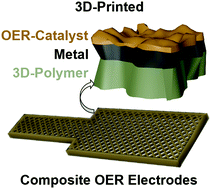A 3d-printed composite electrode for sustained electrocatalytic oxygen evolution†
Abstract
We report the facile design and fabrication of 3D-printed microstructured electrodes for electrocatalytic oxygen evolution. ABS polymer-based mesh scaffolds are chemically functionalized to enable electroless nickel metal deposition and subsequent catalyst (nickel iron hydroxide) immobilization. The resulting composites show sustained oxygen evolution with low overpotentials and high stability. The modular approach reported enables the scalable on-demand fabrication of microstructured composite electrodes.



 Please wait while we load your content...
Please wait while we load your content...